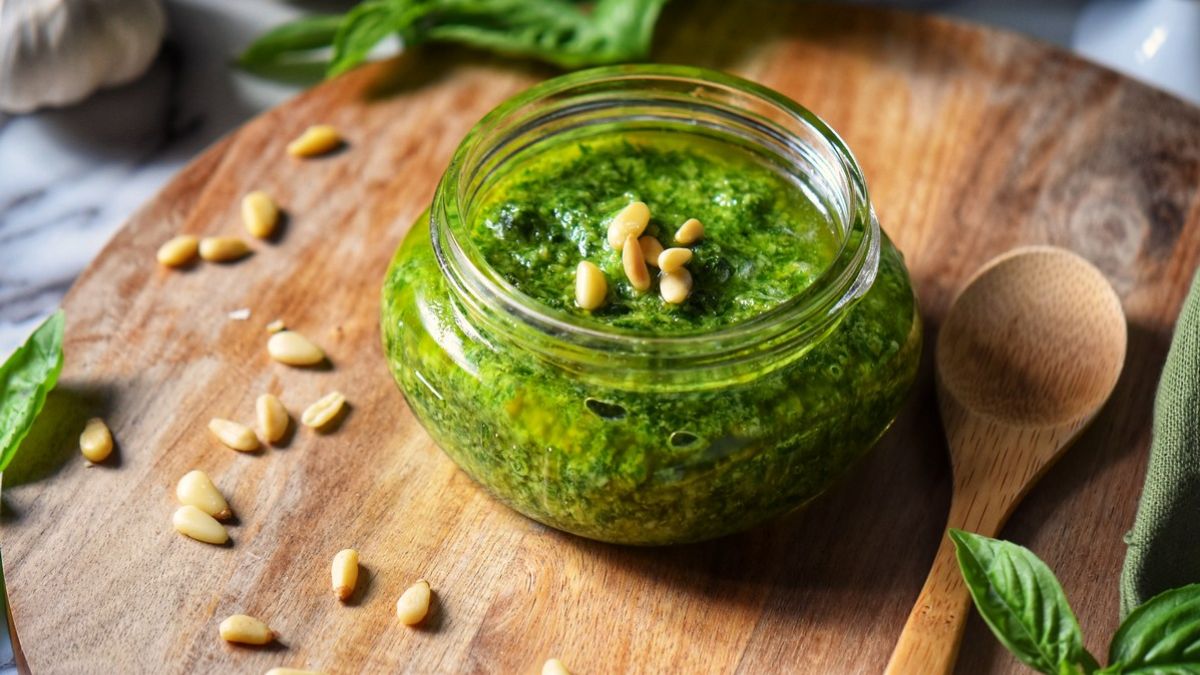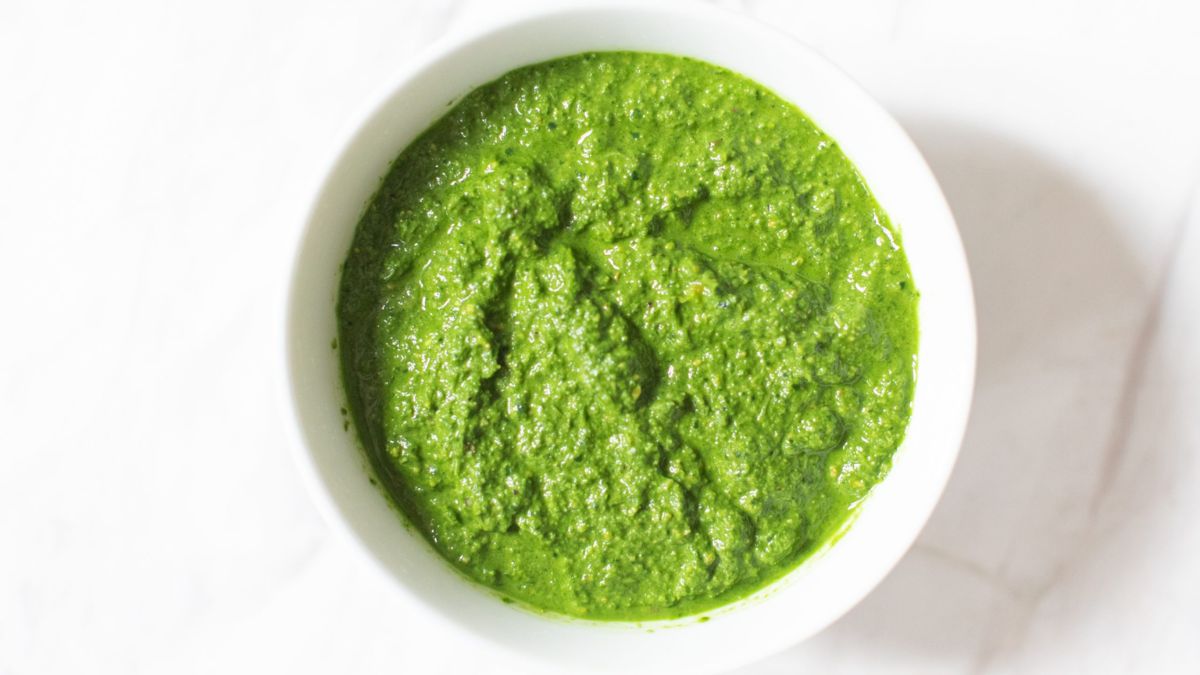The classic “pesto alla Genovese” that originated in Genoa, the capital of Liguria in Italy, is what most people think of pesto. Fresh basil leaves, raw garlic, pine nuts, parmesan, pecorino, olive oil, and salt are used. However, there are hundreds of pesto varieties to choose from, and you may make your own. Try this pesto recipe if you’ve never made it before! It’s simple to make at home, and it’s exceptionally fresh and flavorful.
Pesto is packed with vitamins A, C, calcium, and iron. Unsaturated fats, also known as “good fats,” are responsible for the calories. The fact that it can be used as a substitute for mayo, creamy spaghetti sauces, and ranch dressing, I believe, is the actual health benefit. The boiling water kills the browning enzymes, which causes the leaves—and the resulting pesto—to turn a drab olive colour quickly. A small portion of the flavour is lost in the process, but this keeps the mint from being too strong.
What is Pesto?
Fresh basil, garlic, olive oil, pine nuts, and cheese are mashed into a thick, green paste to make authentic pesto. (The Italian term pesto means “pounded.”) Pesto is often regarded as a Ligurian innovation, whereas classic pesto is sometimes known as pesto Genovese, after Genoa, the capital of Italy’s northwest coast region.
Liguria is known for its buttery-sweet olive oil and moderately spicy basil with a clove-like fragrance. For hundreds of years, pesto was produced by crushing these aromatic herbs together with a mortar and pestle. Making homemade pesto with a blender or food processor is more frequent nowadays.
Homemade Pesto Recipe
Pesto, a paste made from basil, garlic, pine nuts, cheese, and a few additional ingredients, is readily accessible. However, no store-bought pesto can compare to the flavour of homemade pesto. Start preparing pesto when the basil in your garden or market starts to bloom. Serve it on your favourite pasta, as a dip, over freshly boiled potatoes, or drizzled over grilled vegetables once you have delicious homemade pesto. For more ideas, see Pesto Recipes.
Steps to Make it
- Gather the ingredients.
- If you’re blanching the basil, do it now.
- Peel and roughly chop the garlic.
- Put the basil, garlic, olive oil, lemon juice, and salt in a blender or food processor.
- Whirl until the mixture is thoroughly pureed, scraping down the edges to preserve the consistency.
- To maintain the mixture mixing and smooth, add up to 1/2 cup water (adding more oil will make the mixture oily and likely to separate when you serve it).
- Pulse in the pine nuts and cheese until thoroughly combined and chopped.
- Serve with hot spaghetti or refrigerate for up to one week or freeze for six months.
Ingredients
- 5 cups fresh basil leaves
- Four cloves garlic
- 1/2 cup extra-virgin olive oil
- Two tablespoons of lemon juice
- 1/4 teaspoon acceptable sea salt, plus more to taste
- 1/2 cup lukewarm water
- 1/4 cup pine nuts
- 1/2 cup shredded Parmesan cheese or other aged cheese
Homemade Pesto Recipe
What is the Difference Between Pesto, Pistou, and Picada?
There are various ways to make a herbaceous, garlicky condiment paste bonded by nuts and olive oil, some of which have become well-known in their own right. Both of these dishes are easy to prepare.
Pistou. Pistou is a Provençal pesto made with basil, garlic, and olive oil. It’s served with soupe au pistou, a Provençal white bean and vegetable soup. Pistou is an excellent pesto alternative for anyone with a nut or dairy allergies because it is free of nuts and cheese. Pistou has a more robust garlic flavor and is less creamy than pesto.
Picada. Picada contains blanched peeled almonds (sometimes toasted) and hazelnuts or pine nuts, garlic, flat-leaf parsley, and olive oil, similar to a Catalan parsley pesto without the cheese. Black pepper, bread (soaked in milk or vinegar and fried), roasted chile peppers, and paprika are typical additions.
What are the Common Pesto Substitutions?
Any mix of herbs, cheeses, and nuts can be used to make pesto. Experiment with the flavors listed below to create new ones.
For pine nuts, substitute: walnuts; hazelnuts; almonds; pistachios; pecans; sunflower seeds, and macadamia nuts.
For basil, substitute: arugula; parsley; spinach; sorrel; baby chard; sage; marjoram; cilantro; mint; carrot tops; blanched, drained, and cooled kale orchard.
For parmesan, substitute: Pecorino Romano; Asiago; Aged manchego; or other hard, salty cheeses.
What does Pesto Taste Like?
Pesto is a thick, green sauce with a bright, herbaceous flavor from the basil and a salty, rich flavor from the cheeses and pine nuts. It should have a garlicky flavor and a lovely grassiness from good olive oil. The garlic’s bite can be softened by heating the sauce, which can be served with pasta, meats, or vegetables.
What Else can be Added to Pesto?
Instead of basil: Without basil, you can make a variety of pests. Use parsley or coriander as herbs. Soft greens like rockets, spinach, or watercress are excellent choices. Vegetables like kale can also be used, though they may need to be softened by blanching or wilting. This coriander pesto recipe calls for coriander and cashews, and it goes great with creamy chicken curry. Use sun-dried tomatoes instead of greens to make a red pesto. This version is tart and excellent as well.
Instead of pine nuts: Pesto can be made without the expensive pine nuts. Due to their comparable feel, walnuts are a popular replacement. Almonds, cashews, pecans, macadamia nuts, and pistachios are all excellent to blitz. Leave out the nuts for a nut-free pesto and gradually add oil to keep the sauce from becoming overly oily.
Instead of olive oil: If you don’t want to use olive oil, neutral oils like peanut, canola, or grapeseed work nicely. You won’t get the grassy flavor from the olive oil, but you’ll still have a fantastic pesto if you use an excellent green leaf and cheese.
Instead of garlic: Some argue that pesto isn’t pesto without garlic, but you can adjust the amount or leave it out entirely. You’ll still have a tasty sauce that will serve the same purpose.
Now that you know everything there is to know about pesto and how to customize it try making it at home! Check out the video below to see more pesto recipes.
Conclusion
The original pesto recipe is regrettably not vegan because it contains fresh basil, garlic, pine nuts, oil, and parmesan cheese. Thankfully, making a tasty vegan pesto isn’t difficult. Leave out the dairy and combine a few other components. Yes, practically everything is vegan-friendly. Hummus is a vegan staple that gives you some nutritional flexibility. It’s a trendy vegan cuisine so you might have discovered a new favorite. Pesto is roughly translated as paste, although the texture of this uncooked Italian sauce can range from a thick puree to a firm paste depending on the components. Making pesto is simple with a food processor method called “timing the pour,” regardless of the ingredients.
Simply put, Heinz ketchup is suitable for vegans. All of their ingredients are plant-based, but when it comes to Heinz tomato ketchup, they’ve stated that the product is vegan-friendly. ‘We don’t refine our sugar using bone char from animal bones.’ Making it completely vegan-friendly, Pesto blended with olive oil or mayonnaise elevates a standard salad and is ideal for tuna, chicken, and pasta salads. When combined with rice, risotto, mashed potatoes, or dolloped across hot veggies like cauliflower, it can transform ordinary into extraordinary.

